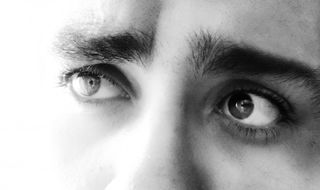Anxiety
Anxiety Sensitivity: When What We Fear Is Fear Itself
The fear of anxiety symptoms underlies many mental health problems.
Posted February 25, 2020 Reviewed by Abigail Fagan
Consider the following questions:
- Is it important to you not to appear nervous?
- Does it scare you when you feel "shaky" (trembling), faint, or nauseous?
- It is important to you to stay in control of your emotions?
- Does it scare you when your heart beats rapidly?
- Do you feel embarrassed around people when your stomach growls?
- Does it scare you when you’re unable to keep your mind on a task?
- Are you afraid of being nervous?
When we think of an anxious or fearful person, we most often imagine someone who’s worried about some object (snake), event (big presentation), or issue (climate change) in the world. For many of us, the experience of anxiety indeed involves such external concerns.
Yet a lesser known fact—but perhaps more important—is that many of those who deal with mental health issues, and anxiety disorders in particular, are not in fact concerned chiefly with objects, events, or issues in the world. Rather, they are afraid of the very bodily sensations of anxiety itself. If you answered "yes" to all or most of the questions above, you may be one of those people.

This phenomenon is known as anxiety sensitivity (or "fear of fear"). Anxiety sensitivity appears to arise mostly as a consequence of learning experiences in the individual’s background. Research suggests that stressful life events, specifically those related to health and family discord, are associated with increases in anxiety sensitivity. These stressful events contribute to the emergence of anxiety sensitivity by leading to the formation of distorted, dysfunctional beliefs about the meaning and consequences of somatic sensations. The documented links between anxiety sensitivity and both non-anxiety problems and medical conditions suggest that "fear of fear" may be a component of a more general category of somatic fears—a negative preoccupation with bodily sensations.
People high in anxiety sensitivity are afraid of their own anxiety symptoms—irregular breathing, heart palpitations, trembling, flushing, sweating, and stomach rumbling. Specifically, they fear that these symptoms: 1. Are easily observed by others (“everyone can see I’m trembling”); 2. Will lead to a loss of control and social embarrassment (“I’m going to trip and make a fool of myself”); 3. Are signs of imminent physical or mental illness (“I’m having a heart attack;” “I’m going to faint;” “I’m going crazy”).
The bad news here is that research has demonstrated quite convincingly that high anxiety sensitivity is a risk factor for mental health. Anxiety sensitivity predisposes people to the development and maintenance of various psychiatric conditions, most notably anxiety disorders (and among those, most notably panic disorder). Anxiety sensitivity predicts well the incidence of anxiety and other disorders even in individuals with no prior history of a mental health diagnosis, and its role in the development of anxiety disorders is unique, and appears to matter independently of other factors such as psychological distress or trait anxiety.
Anxiety sensitivity is an especially insidious foe because it is internal to the individual, and therefore cannot be escaped or resolved merely by changing one’s environment. Moreover, the bodily sensations that are the primary objects of such fear of fear are in fact benign, emerging from the activation of our fight-or-flight nervous system response, which is an innate, biological adaptation designed to alert and protect us from external threats.
The good news here is that targeting anxiety sensitivity directly in psychotherapy has been shown to produce good results for anxious clients. In fact, a reduction in anxiety sensitivity is one of therapy's "active ingredients" responsible for success in treating problems such as panic disorder, specific phobia, social anxiety disorder, post-traumatic stress disorder, and obsessive-compulsive disorder.
In contemporary therapy, high anxiety sensitivity is often targeted and reduced via a variety of interventions. These may include the following:
Psychoeducation—which involves teaching the client (and their support system when applicable) about their diagnosis—the processes and dynamics involved. In the case of anxiety sensitivity, psychoeducation may involve providing the client with information about the physiology of anxiety, how the fight-or-flight system works, and the actual meaning of the various attendant bodily sensations.
Cognitive Restructuring—which focuses on identifying, challenging, and replacing the client’s distorted beliefs and predictions. In the case of anxiety sensitivity, this process may involve looking at the client’s beliefs related to the bodily symptoms of anxiety, their effects, and consequences. A client’s distorted belief (“everyone can see I’m nervous; they’re all going to hate my presentation; I’ll faint mid-sentence”) may be challenged by a review of the evidence ("what are the odds that everyone can tell you're nervous? Have you ever fainted? Do you judge nervous presenters hatefully?") and replaced with more accurate, less catastrophic self-talk ("Some people will see I’m nervous, but most of those will understand; some will dislike my presentation but others may enjoy it; I may feel nervous, but I'm unlikely to faint").
Emotional Acceptance—which involves teaching clients to observe their own emotional reactions mindfully and with curiosity, rather than attempting to fight, control, or deny them. Such emotional acceptance has been shown to be effective in reducing fear of fear.
Interoceptive Exposure—which involves exposing the client to their own bodily sensations and training them to manage the symptoms rather than fear, avoid, or seek to escape them. Interoceptive exposure practice usually begins in session, after the client and therapist have figured out which stimuli will effectively provoke the client’s fight-or-flight response. Several common such exercises include breathing through a straw, spinning in an office chair, hyperventilating intentionally, or looking intently into a mirror. Once the symptoms are provoked, the client is instructed to allow themselves to experience them and report periodically on their severity until habituation (a reduction in symptoms due to prolonged exposure) is evident. Homework may be later assigned for the client to practice at home.
In Vivo Situational Exposure—in which the client is instructed to face their fear by approaching and remaining in feared situations. Exposure works to reduce fear of fear through several paths. First, it allows the nervous system to habituate to the feared situation (thus reducing noxious fight-or-flight symptoms). Second, it allows for new learned coping responses to override the influence of earlier, learned fear responses. Third, it allows the client to become skilled at managing anxiety, its bodily symptoms and the situations that provoke them. Fourth, as previously dreaded and avoided situations and sensations are faced and managed, the client gains a sense of psychological empowerment, which serves as a confidence boost, and a motivator to continue the work.
FDR once famously said, “The only thing we have to fear is fear itself.” But when it comes to mental health, fearing fear is a mistake, and a problem. Becoming aware of the construct of anxiety sensitivity may help you understand better your own mental health challenges as well as mark the path to health. Several validated, high-quality clinical instruments (such as the ASI-3) are available to diagnose anxiety sensitivity. If you suspect that anxiety sensitivity may be at the core of your mental health issues, and if your hunch is confirmed by a professional assessment process, then looking for therapy interventions that target the construct directly may prove highly beneficial.




